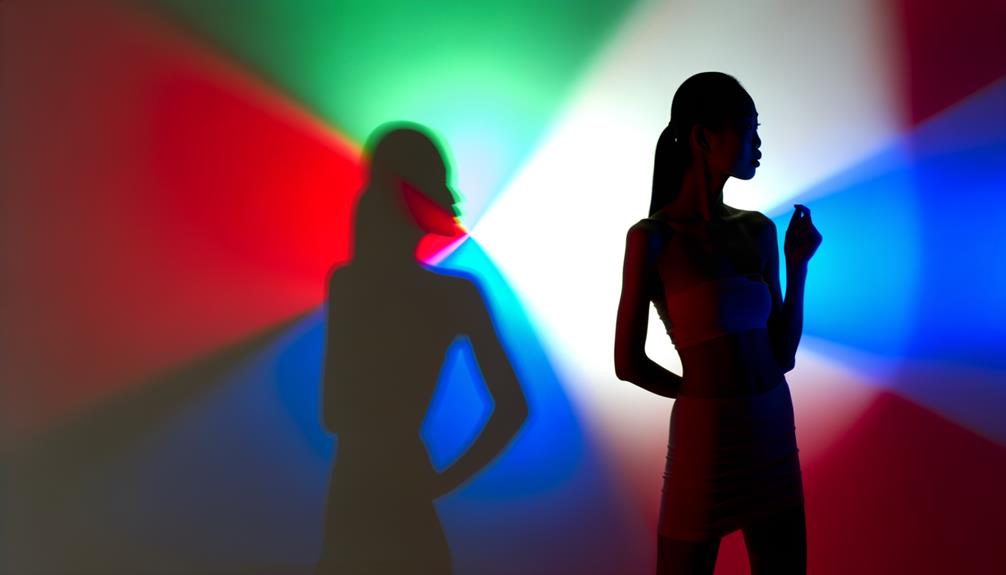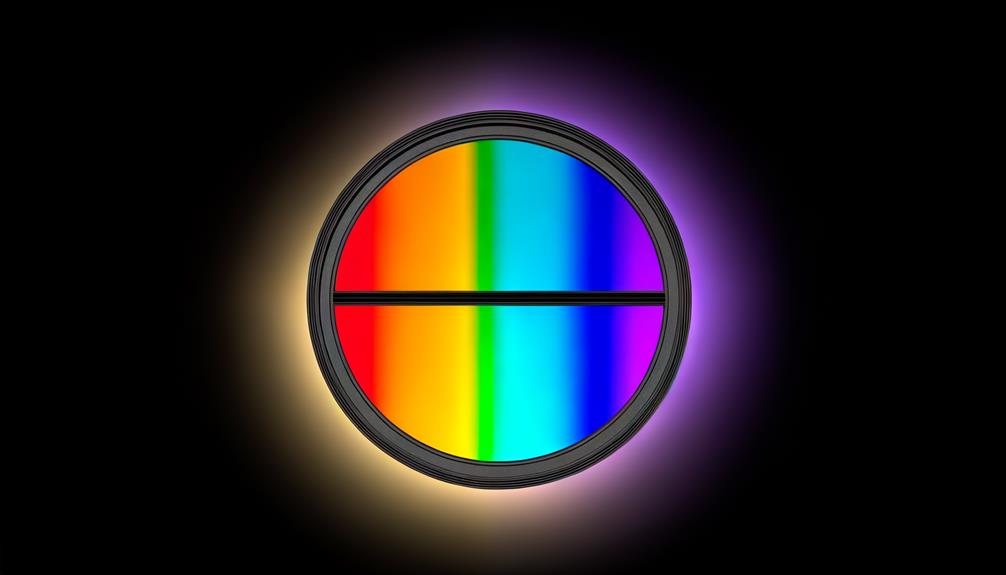Begin a vibrant journey through the science of color with these 7 enchanting experiments. You'll harness the power of prisms to separate white light into a dazzling spectrum, bend light through transparent materials, and create colorful shadows. Spin a color wheel to witness optical illusions, mix wavelengths to produce a broad palette, and marvel at the iridescent hues of soap bubbles. Discover the secrets of polarizing filters and their ability to manipulate light. As you explore each experiment, you'll uncover the fascinating principles that govern the world of color and light. Let's plunge into it and see what wonders await!
Prism Power
Bending light into a stunning spectrum of colors, a prism is a powerful tool for exploring the science behind rainbows. When you shine a beam of white light through a prism, it refracts, or bends, separating into the visible wavelengths that make up the color spectrum: red, orange, yellow, green, blue, indigo, and violet (ROYGBIV).
This occurs because each color travels at a slightly different speed through the prism's glass.
To witness this phenomenon, find a room with a sunny window and hold a prism near the beam of light. Rotate the prism until you see a rainbow projected on a nearby wall or white surface. Experiment with different angles and distances to see how the spectrum changes.
You can also try using different light sources, like a flashlight or a colored LED, to observe how the prism affects various wavelengths. By exploring the properties of light with a prism, you'll gain a deeper understanding of the science behind color and refraction, and you'll be able to create your own miniature rainbows whenever you desire.
Bending Light
Light's fascinating ability to bend, or refract, as it passes through various materials is the key to understanding the enthralling colors produced by a prism.
When light travels through a transparent material like glass or water, it slows down and changes direction, causing it to bend. The amount of bending depends on the material's refractive index and the light's wavelength. This is why you see a rainbow when light passes through a prism:
- Red light, with its longer wavelength, bends the least
- Orange and yellow light bend slightly more
- Green and blue light bend even more
- Violet light, with its shorter wavelength, bends the most
As the white light separates into its constituent colors, you can marvel at the spectrum created by the prism.
Experiment with different prism shapes, sizes, and materials to observe how they affect the refraction and dispersion of light. You can also try shining light through water or other transparent liquids to witness the mesmerizing dance of colors.
Colored Shadows

Another enchanting color experiment involves exploring the world of colored shadows. To observe this phenomenon, you'll need a white surface, a bright light source, and colored cellophane or translucent filters. Set up the light to shine on the white surface, then hold an object to cast a shadow. Cover the light with a colored filter and observe the shadow's hue. Experiment with different color combinations for mesmerizing results.
| Filter Color | Shadow Color | Complementary Color |
|---|---|---|
| Red | Cyan | Green |
| Green | Magenta | Red |
| Blue | Yellow | Orange |
| Yellow | Blue | Purple |
| Magenta | Green | Cyan |
The colored shadows occur due to the light's interaction with the object and the colored filter. The filter absorbs certain wavelengths of light, while the object's shadow is illuminated by the remaining wavelengths, resulting in the perception of a complementary colored shadow. This experiment demonstrates the fascinating interplay between light, color, and our visual perception, showcasing how our eyes and brain interpret the world around us.
Spinning Color Wheel
When you spin a color wheel containing the primary colors, they appear to blend together into white due to an optical illusion.
You can easily create your own spinning color wheel at home with simple supplies.
Let's explore the science behind this mesmerizing effect and how you can replicate it yourself.
Primary Colors Blend
Grab a color wheel and give it a spin to see the primary colors blend together right before your eyes. As the wheel rotates faster, the distinct colors seem to disappear, merging into a single shade. This mesmerizing effect is caused by the way our eyes perceive color and the limitations of our visual processing speed.
Here's what's happening:
- The primary colors (red, blue, and yellow) are arranged on the wheel in a specific pattern.
- As the wheel spins, your eyes receive rapid flashes of each color too quickly for your brain to process individually.
- Your brain averages the colors together, creating the illusion of a single, uniform color.
- The faster the wheel spins, the more seamless the blending appears, often resulting in a whitish or grayish color.
This experiment demonstrates the principles of color mixing and the phenomenon of persistence of vision.
It's a simple yet fascinating way to explore the science behind color perception and how our eyes and brain work together to interpret the world around us.
Optical Illusion Explained
The spinning color wheel experiment is a prime example of an optical illusion. When you spin a wheel with different colored sections, your eyes perceive it as white or off-white. This happens because the colors blend together too quickly for your brain to process them individually.
To create this illusion, divide a circular piece of cardboard into equal sections and color each one with a different hue. Make sure to use colors that are evenly spaced on the color wheel, such as red, orange, yellow, green, blue, and violet. Attach the wheel to a motor or spin it rapidly using a dowel or pencil.
As the wheel spins faster, the colors will appear to merge, creating the illusion of a single, uniform color. This phenomenon demonstrates the concept of persistence of vision, where an afterimage lingers briefly in your eye, allowing the colors to blend seamlessly.
The spinning color wheel is a fascinating way to explore the science of color mixing and the limitations of human visual perception, showcasing how our brains interpret the world around us.
DIY Color Wheel
To create your own spinning color wheel, you'll need a few simple materials. Gather a white cardboard circle, markers or paints in the colors of the rainbow (red, orange, yellow, green, blue, and violet), a pencil, and a thumbtack. Here's how to make your color wheel:
- Divide the cardboard circle into six equal sections using the pencil and ruler.
- Color each section with one of the rainbow colors, starting with red and following the order mentioned above.
- Push the thumbtack through the center of the circle and attach it to the eraser end of the pencil.
- Spin the pencil between your hands and watch as the colors blur together, creating the illusion of white light.
As the wheel spins, your eyes mix the colors together rapidly, demonstrating that white light is a combination of all the colors in the visible spectrum.
This simple experiment helps you understand the basics of additive color mixing, which is how our eyes perceive color in light sources like screens and projectors.
Mixing Wavelengths

Let's explore what happens when you mix different colors of light.
By combining red, green, and blue (RGB) light in various proportions, you can create a wide spectrum of colors.
This process, known as additive color mixing, is the foundation for how digital screens and displays generate vibrant hues.
Primary Color Combinations
Three primary colors of light exist: red, green, and blue. When you combine these colors in different ways, you'll create new colors.
Here's what happens when you mix the primary colors:
- Red + Green = Yellow
- Red + Blue = Magenta
- Green + Blue = Cyan
- Red + Green + Blue = White
By adjusting the intensity of each primary color, you can create a wide range of hues. This is how your TV or computer monitor displays colors. Each pixel on the screen is made up of tiny red, green, and blue subpixels that emit light at different intensities to create the perceived color.
To explore color mixing, try using a set of red, green, and blue flashlights or LED lights. Shine them on a white surface and overlap the colors to see the results.
You can also use colored cellophane or gel filters to cover the lights and mix the colors. Experiment with different combinations and intensities to discover the many colors you can create using just three primary colors of light.
Additive Color Mixing
Additive color mixing involves combining different wavelengths of light to create new colors. You can see this in action with an RGB LED flashlight. The LEDs emit red, green, and blue light, and by adjusting their intensities, you can create a wide range of colors. For example, equal amounts of red and green light produce yellow, while blue and green create cyan.
To experiment with additive color mixing, you'll need a dark room and three flashlights with red, green, and blue filters. Shine the flashlights on a white surface, overlapping the beams. You'll see that the areas where two colors overlap produce secondary colors (yellow, cyan, and magenta), while the area where all three overlap appears white.
This principle is used in electronic displays, such as TVs and computer monitors, where tiny red, green, and blue subpixels are combined to create the colors you see on the screen.
RGB Light Blending
By blending red, green, and blue light in varying proportions, you can create a stunning array of colors. This process, known as RGB light mixing, is the foundation of how digital screens display color.
Here's what you need to explore this phenomenon:
- Three flashlights or LED light sources (red, green, and blue)
- A dark room or a dark surface to project the lights onto
- Colored cellophane or transparent colored plastic to cover the light sources
- A white surface or wall to observe the blended colors
Experiment with different combinations of the three primary colors by adjusting the intensity and proximity of the light sources. You'll discover that red and green light create yellow, green and blue light make cyan, and blue and red light produce magenta.
When you mix all three colors in equal proportions, you'll see white light. By understanding RGB light mixing, you'll gain insight into how digital devices create the vibrant colors you see on screens, from smartphones to televisions.
This knowledge also has practical applications in fields like graphic design, photography, and lighting design.
Soap Bubble Rainbows
Soap bubbles fascinate both children and adults with their iridescent colors that shimmer and change as the bubbles float through the air.
These mesmerizing colors are caused by light waves reflecting off the thin soap film, creating a phenomenon called thin-film interference. As light hits the outer and inner surfaces of the bubble, some light waves reflect while others pass through. The reflected waves interfere with each other, either reinforcing or canceling out certain colors depending on the thickness of the soap film.
To observe this enchanting effect, you'll need a bubble solution made with dish soap, water, and glycerin or corn syrup.
Blow bubbles and watch as they display a spectrum of colors that shift and change as the bubble's surface stretches and thins. The colors you see depend on the bubble's thickness, with thicker areas appearing more red and thinner areas appearing more blue.
As the bubble pops, you'll witness a rapid progression of colors, demonstrating how the soap film's thickness affects the colors produced by thin-film interference. This simple yet stunning experiment showcases the intriguing interaction between light and soap bubbles.
Polarizing Filters

Polarizing filters are a fascinating tool for exploring the properties of light. They allow you to selectively block certain light waves based on their orientation.
Here's what you can discover with polarizing filters:
- Glare reduction: Place a polarizing filter in front of a light source and rotate it. You'll notice how glare and reflections can be reduced or eliminated at certain angles.
- Hidden stress patterns: Look at clear plastic objects like rulers or CD cases through a polarizing filter. Rotate the filter to reveal colorful stress patterns caused by the manufacturing process.
- Sky polarization: Hold a polarizing filter up to the sky and rotate it. The blue sky will darken as you align the filter with the polarized light scattered by the atmosphere.
- Liquid crystal displays: Examine an LCD screen through a polarizing filter. Rotating the filter will cause the screen to appear black at certain angles, demonstrating how these displays manipulate polarized light.
Frequently Asked Questions
What Causes the Colors of the Rainbow?
When sunlight passes through raindrops, it's refracted and reflected, splitting into different wavelengths. Each wavelength corresponds to a specific color, and they always appear in the same order: red, orange, yellow, green, blue, indigo, and violet.
How Do Our Eyes Perceive Different Colors?
Your eyes perceive colors when light enters and stimulates different cone cells. There are three types of cones, each sensitive to specific wavelengths: red, green, and blue. Your brain then interprets these signals as color.
Why Does the Sky Appear Blue During the Day?
When you look at the sky during the day, it's blue because sunlight entering Earth's atmosphere is scattered by air molecules. Blue light scatters more than other colors, making the sky appear blue to your eyes.
How Do Colors Influence Our Emotions and Behavior?
Colors powerfully influence your emotions and behavior. Warm hues like red and yellow energize and excite you, while cool blues and greens calm and soothe. Colors affect your mood, productivity, and decision-making, often subconsciously.
What Is the Difference Between Additive and Subtractive Color Mixing?
Additive color mixing combines colored lights to create white light. Subtractive mixing uses pigments or dyes that absorb certain wavelengths and reflect others, producing the color you see when white light shines on them.
Conclusion
You've explored the wondrous world of color through these vibrant experiments! From bending light with prisms to mixing wavelengths and creating soap bubble rainbows, you've discovered how light interacts to produce the stunning hues we see. Keep experimenting and observing closely – there's so much more to uncover about the science of color! Whether you're spinning a color wheel or playing with polarizing filters, you're bound to find endless fascination in the spectrum of light.




Leave a Reply